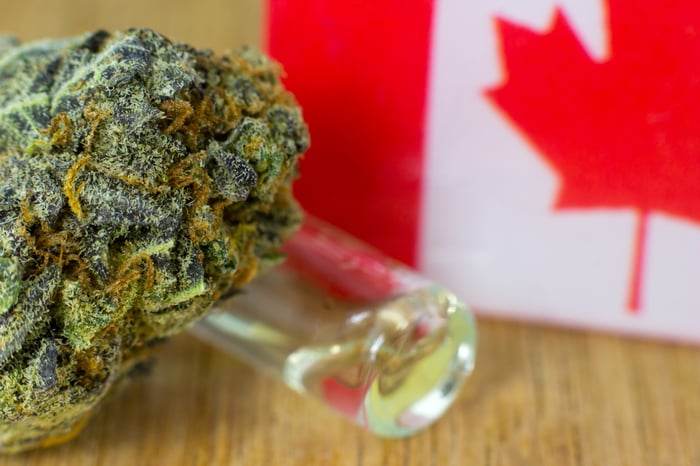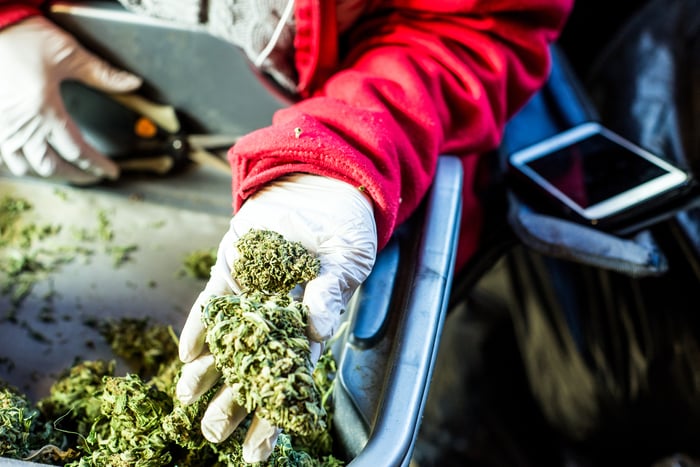In November 2018, marijuana looked to be the hottest investment since sliced bread. Just a few weeks prior, Canada had become the first industrialized country in the world to legalize adult-use marijuana, and the broad-based expectation on Wall Street, as well as among independent analysts, was that pot stocks could quickly grow their sales and generate a profit.
The State of the Legal Cannabis Markets report, published earlier this year by Arcview Market Research and BDS Analytics, offered just a taste of the industry's potential. Between 2014 and 2018, worldwide revenue more than tripled from $3.4 billion to $10.9 billion, with the report suggesting that global sales could hit more than $40 billion by 2024. Even though Canada wasn't expected to lead the path forward -- that's reserved for the crown jewel of the cannabis movement, the United States -- it was still expected to generate north of $5 billion in annual sales in roughly five years' time.

Image source: Getty Images.
Canada's green rush fizzles out
And yet, here we are, more than a full year after Canada legalized recreational marijuana, and our neighbor to the north looks like a shell of the image investors had created just a year prior.
Although we're still awaiting data from Statistics Canada on cannabis store sales for September and October, it's likely that our northerly neighbor amassed between 1 billion Canadian dollars ($761 million) and CA$1.1 billion ($837 million) in first-year sales, on a trailing 365-day basis. That's highly disappointing given the hype surrounding the launch of recreational weed products last year.
Much of this disappointment can essentially be boiled down to two major issues. First, there's Health Canada, the regulatory agency tasked with overseeing Canada's legal industry. No one can fault the agency for being so thorough in its licensing process. However, Health Canada began the year with more than 800 cultivation, processing, and sales license applications on its desk awaiting review. Even with midyear changes designed to expedite the cultivation review process, it's clearly slowed the path of legal product to market.
Secondly, some finger-pointing is deserved at certain Canadian provinces. Ontario, a province of 14.5 million people, only has one open dispensary for every approximately 604,200 people. It could likely accommodate 25 to 40 times as many open dispensaries, yet has been slow to approve licensing for physical dispensaries. Together, this slow rollout of licensed retail stores and Health Canada's licensing backlog have led to a resurgence in black market marijuana sales.

Image source: Getty Images.
Here's how you'll know the pot industry is turning the corner
But there is light at the end of the tunnel. Growing pains in the marijuana industry were fully expected, and robust long-term sales forecasts can still be met. However, it's important that investor can recognize the signs that the Canadian cannabis industry is turning the corner.
Significant margin improvement
While it's probably easy to get roped in by something as simple as revenue growth, an increase in sales (even a substantive increase) doesn't mean that a specific company, or the industry as a whole, has turned the corner. We've witnessed sales rise for a number of cannabis stocks, but their expenses have grown even faster.
Sales growth also fails to account for the changing market conditions in Canada. For instance, both HEXO (HEXO) and Green Organic Dutchman (TGOD.F) recently announced production cutbacks to more accurately reflect the near-term demand outlook. HEXO will be idling the Niagara facility, which was acquired via the Newstrike Brands purchase. Meanwhile, Green Organic Dutchman plans to operate just four grow rooms from its flagship Valleyfield property, yielding an estimated 10,000 kilos from these rooms in 2020, compared to a peak annual forecast for this property of 130,000 kilos.
Instead of sales, focus on margins. Wall Street wants to see that cannabis can be a viable long-term industry that can effectively compete against the black market. Therefore, an industrywide improvement in gross margin would go a long way to signaling a turnaround.

Image source: Getty Images.
Aside from a more prudent spending strategy, which is what we're seeing from HEXO and Green Organic Dutchman, the launch of derivative products (e.g., edibles, vapes, infused beverages, topicals, and concentrates) is expected to play a major role in boosting margins. Dried flower has shown a penchant for oversupply and commoditization in select recreationally legal U.S. states, making high-margin derivatives a big focus for cannabis stocks.
Regulations for derivatives went into effect on Oct. 17, 2019, with product set to hit dispensary store shelves by mid-December. Remember, though, that the supply issues impacting dried flower will also be a nuisance to derivative products in the near term.
A substantial pickup in international sales
The other sign that investors should look for that may very well signal a turnaround in the Canadian pot industry is a pickup in overseas sales.
I know what you're probably thinking: "How does a substantial increase in international revenue for Canadian pot stocks signal that Canada's marijuana industry is getting healthier?" The thing is, Health Canada is counting on producers to take care of domestic demand before shipping sizable amounts of product to overseas markets. Therefore, if we begin to see a significant uptick in international sales, it would signal that an increasing amount of domestic demand is being met, thereby allowing growers to export and/or focus their efforts on international sales channels.

Image source: Getty Images.
However, understand that a few growers already have a sizable international presence, so this'll need to be factored in when you're keeping a close watch on international marijuana sales growth. For example, Aurora Cannabis (ACB 1.34%) has 132,000 kilos of peak annual output forecast for Europe, with the joint venture Aurora Nordic 2 campus -- which is capable of yielding at least 120,000 kilos of output per year -- coming on line in 2020. This means Aurora should be able to run circles around most other pot stocks with regard to international sales. This doesn't mean, though, that Aurora or its peers will necessarily have seen domestic supply issues resolved.
Canopy Growth (CGC 7.14%), the largest marijuana stock by market cap, might actually be a great measure of overseas sales growth. This is a company with a presence in 17 countries, including Canada, but without the huge overseas production presence. This means most of Canopy Growth's overseas revenue (from cannabis) is liable to generated from exports. Keeping a close eye on Canopy's international sales could be telling as to whether Canada's pot industry is turning the corner.





